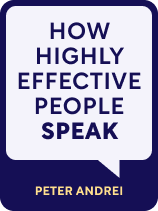

This article is an excerpt from the Shortform book guide to "How Highly Effective People Speak" by Peter Andrei. Shortform has the world's best summaries and analyses of books you should be reading.
Like this article? Sign up for a free trial here.
What made John F. Kennedy such an effective communicator? How might you use the same techniques?
If you want to influence people, you must understand what makes them tick. In How Highly Effective People Speak, Peter D. Andrei shows how to take advantage of cognitive biases to persuade people. One of these is the contrast effect bias.
Continue reading to see how using the contrast effect in your communication is one of the most effective ways to improve your rhetorical skills.
Contrast Effect Bias
The contrast effect is the tendency to judge things presented closely together or in rapid succession together rather than separately, and it can strengthen or weaken perceived differences and similarities between two or more things. Like the anchoring bias, the contrast effect relies on our inability to judge things without a point of comparison. The contrast effect, however, doesn’t necessarily rely on the initial point of reference as the anchoring bias does. Instead, it’s activated by ongoing comparisons between two things.
For example, you could be presented with two things simultaneously, and this comparison would affect your perception of both of them. If you see a new boat right next to an old, rundown one, the new boat will seem even better than it actually is while the used one will seem even worse.
(Shortform note: One area in which contrast effect bias can negatively impact decision-making is in the hiring process. When hiring out of a pool of candidates, recruiters will naturally compare each candidate to the rest of the pool instead of evaluating each candidate individually. This can result in a weak candidate looking stronger than they should, or it can lead to overlooking someone who’s perfect for the job because they get lost in a sea of other strong applicants. To avoid this, some companies avoid using CVs and instead use work samples, which can more effectively show a candidate’s potential.)
Andrei provides several examples of how you can use the contrast effect in your speech or writing to make it more persuasive.
Use antithesis: Antithesis refers to presenting strongly contrasting or opposite ideas together for dramatic persuasive effect. “Not ___, but ___.” Andrei points out that President John F. Kennedy used this strategy to great effect in his famous line, “Ask not what your country can do for you; ask what you can do for your country.”
| Antithesis and Antimetabole in Kennedy’s Inaugural Address Andrei points to John F. Kennedy’s famous line from his 1961 inaugural address as an example of antithesis, but the rest of Kennedy’s famous speech is filled with antithesis as well. In the opening, he says, “We observe today not a victory of party but a celebration of freedom.” Later, he says, “We offer not a pledge but a request: that both sides begin anew the quest for peace.” Just after, he says, “Not a new balance of power, but a new world of law.” And he follows up his famous “ask not” line with another: “Ask not what America will do for you, but what together we can do for the freedom of man.” Kennedy’s famous “Ask not what you can do” line is also an example of another rhetorical device: antimetabole. Antimetabole is when the words of a sentence are repeated in reverse order, as in, “When the going gets tough, the tough get going.” This symmetrical structure is artistically pleasing and helps the phrase stick in the audience’s mind, which is perhaps one reason that Kennedy’s phrase is so well remembered decades later. |
Present and decline other options: To make use of the contrast effect and make your idea seem better by comparison, you need to present other options. If the alternatives you present are obviously inferior to your proposal, you can leave them be. If there is room for debate on which idea is better, you need to settle this debate by showing the benefits of your product or idea or the drawbacks of the alternative. For example, in a sales presentation, you might say, “The [competitor’s product] can do this, while [your product] can do the same thing for half the price.”
(Shortform note: Business experts call this use of the contrast effect a technique of “low-pressure selling,” in which the salesman doesn’t try to coerce a customer into buying something they don’t want but instead lets them make the decision on their own. The contrast effect can be used no matter how similar the competing products are, or even if the product you’re selling is inferior in many ways, because there will almost always be at least one area in which your product is better. Simply pointing out the advantages of your product in an approachable (low-pressure) way can significantly increase your sales.)
Create contrast in the diction: You can use the contrast effect not only in the content of your argument but also in the way you present it. Andrei provides two ways of doing this, both of which involve starting a pattern in your speech or writing and then breaking it to provide persuasive emphasis. For example, speak quickly and loudly for a few sentences then stop, slow down, and speak quietly when emphasizing a point. In writing, you could use a repetitive phrase and then break the pattern for emphasis: “Renewable energy will give us healthier air, healthier water, healthier children, a healthier economy, a healthier planet; oil gives us pollution, greed, and war.”
| Pattern-Breaking: How to Use It and Why It’s Effective In TED Talks, Chris Anderson provides specific advice for how to vary your speech rate. He advises speaking more quickly when telling a story or anecdote because people can easily process information presented in this form. When explaining a theory or concept, slow down, as the audience will need time to fully understand and appreciate what you’re saying. These pattern-breaking techniques may be effective because of the human brain’s pattern-seeking tendency. Humans are wired to seek and find patterns, and some argue that our superior pattern processing is why we have such a strong capacity for reasoning, communication, and abstract thought. So when you establish a pattern and then break it, an audience will subconsciously notice this abrupt change because they’re hardwired to. |

———End of Preview———
Like what you just read? Read the rest of the world's best book summary and analysis of Peter Andrei's "How Highly Effective People Speak" at Shortform.
Here's what you'll find in our full How Highly Effective People Speak summary:
- That persuasive speech is a complex craft that can be studied and learned
- How to take advantage of cognitive biases to be more persuasive
- Why trying to manipulate others' thoughts isn't inherently immoral






